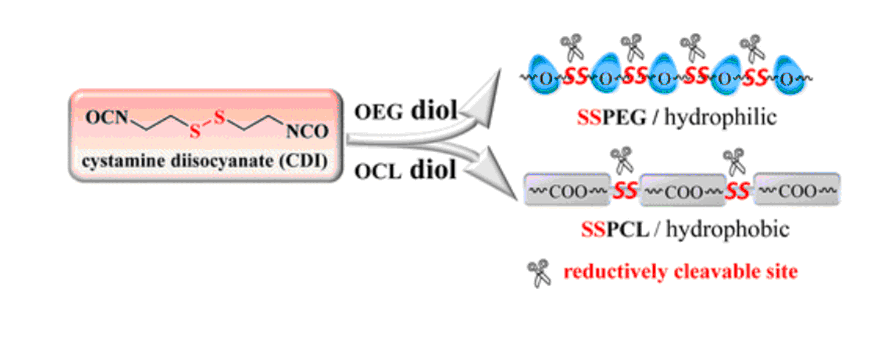Xiuxiu Wang, Jian Zhang, Ru Cheng*(程茹), Fenghua Meng, Chao Deng, and Zhiyuan Zhong*(钟志远)
Biomedical Polymers Laboratory and Jiangsu Key Laboratory of Advanced Functional Polymer Design and Application, College of Chemistry, Chemical Engineering, and Materials Science, Soochow University
Biomacromolecules, 2016, 17 (3), 882–890
Reductively degradable biopolymers have emerged as a unique class of smart biomedical materials. Here, a functional coupling agent, cystamine diisocyanate (CDI), was designed to offer a facile access to reductively degradable biopolymers via polycondensation with various diols. CDI was readily obtained with a decent yield of 46% by reacting cystamine dihydrochloride with triphosgene. The polycondensation of oligo(ethylene glycol) diol (Mn = 0.4 or 1.5 kg/mol) or oligo(ε-caprolactone) diol (Mn = 0.53 kg/mol) with CDI in N,N-dimethylformamide at 60 °C using dibutyltin dilaurate as a catalyst afforded reductively degradable poly(ethylene glycol) (SSPEG, Mn = 6.2–76.8 kg/mol) or poly(ε-caprolactone) (SSPCL, Mn = 6.8–16.3 kg/mol), in which molecular weights were well controlled by diol/CDI molar ratios. Moreover, PEG-SSPCL-PEG triblock copolymers could be readily prepared by reacting dihydroxyl-terminated SSPCL with PEG-isocyanate derivative. PEG-SSPCL-PEG with an Mn of 5.0–16.3–5.0 kg/mol formed small-sized micelles with an average diameter of about 85 nm in PB buffer. The in vitro release studies using doxorubicin (DOX) as a model drug showed that, in sharp contrast to reduction-insensitive PEG-PCL(HDI)-PEG controls, drug release from PEG-SSPCL-PEG micelles was fast and nearly complete in 24 h under a reductive condition containing 10 mM glutathione. The confocal microscopy experiments in drug-resistant MCF-7 cells (MCF-7/ADR) displayed efficient cytoplasmic DOX release from PEG-SSPCL-PEG micelles. MTT assays revealed that DOX-loaded PEG-SSPCL-PEG micelles were much more potent against MCF-7/ADR cells than reduction-insensitive PEG-PCL(HDI)-PEG controls (IC50: 6.3 vs 55.4 μg/mL). It should further be noted that blank PEG-SSPCL-PEG micelles were noncytotoxic up to a tested concentration of 1 mg/mL. Hence, cystamine diisocyanate appears to be an innovative coupling agent that facilitates versatile synthesis of biocompatible and reductively degradable biopolymers.

链接://pubs.acs.org/doi/abs/10.1021/acs.biomac.5b01578